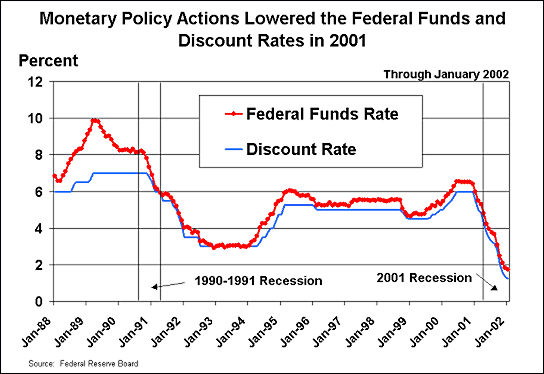Federal Reserve Board Chairman Alan Greenspan’s recent testimony before Congress and the Fed’s Monetary Policy Report submitted to Congress on February 27, 2002, carefully describe the deterioration in the economy in 2001. Both also highlight the Fed’s monetary policy efforts to counteract the slowing economy by lowering interest rates in the federal funds market-overnight loans between banks1-and at the discount window-overnight loans made by Federal Reserve Banks to depository institutions.2 In the paragraphs below I’ve included excerpts from the Monetary Policy Report that comment on the economic situation in 2001 and the Fed’s policy responses. For additional detail, I’d recommend reviewing the February 2002 Monetary Policy Report online at the Federal Reserve Board’s website.
The slowdown in the growth of economic activity that had become apparent in late 2000 intensified in the first half of the year (2001). Businesses slashed investment spending–making especially deep cuts in outlays for high-technology equipment–in response to weakening final demand, an oversupply of some types of capital, and declining profits. As actual and prospective sales deteriorated, many firms in the factory sector struggled with uncomfortably high levels of inventories, and the accompanying declines in manufacturing output steepened. At the same time, foreign economies also slowed, further reducing the demand for U.S. production. The aggressive actions by the Federal Reserve to ease the stance of monetary policy in the first half of the year provided support to consumer spending and the housing sector. Nevertheless, the weakening in activity became more widespread through the summer, job losses mounted further, and the unemployment rate moved higher. With few indications that economic conditions were about to improve, with underlying inflation moderate and edging lower, and with inflation expectations well contained, the Federal Reserve continued its efforts to counter the ongoing weakness by cutting the federal funds rate, bringing the cumulative reduction in that rate to 3 percentage points by August.
The devastating events of September 11 further set back an already fragile economy. Heightened uncertainty and badly shaken confidence caused a widespread pullback from economic activity and from risk-taking in financial markets, where equity prices fell sharply for several weeks and credit risk spreads widened appreciably. The most pressing concern of the Federal Reserve in the first few days following the attacks was to help shore up the infrastructure of financial markets and to provide massive quantities of liquidity to limit potential disruptions to the functioning of those markets. The economic fallout of the events of September 11 led the Federal Open Market Committee (FOMC) to cut the target federal funds rate after a conference call early the following week and again at each meeting through the end of the year.3
The chart shows the impact of the FOMC’s 2001 monetary policy decisions on the federal funds and discount rates. It indicates the progressive declines in both rates during 2001 as the Fed sought to use monetary policy to stimulate the weak economy. As a result of those 2001 decisions, both rates are low by historic standards. In January 2002, the Federal Reserve’s federal funds rate target of 1.75 percent resulted in the lowest average federal funds market interest rates since 1961. The January 2002 discount rate of 1.25 percent was the lowest since 1948.

Endnotes
1. The federal funds market is a market for overnight loans of immediately available funds. The Federal Reserve uses this market to implement monetary policy. When the Fed buys (sells) U.S. Treasury securities from bank dealers it adds (subtracts) funds in this market and lowers (raises) the federal funds rate. On a typical day over $100 billion in federal funds loans are transacted between depository institutions, making this market an important source of short-term depository institution funding. For additional information, see Chapter 2, Federal Funds, in Instruments of the Money Market, FRB Richmond, which is available on line at: http://www.rich.frb.org/pubs/instruments/
2. The discount rate is the interest rate that Federal Reserve Banks charge when they make discount window loans to depository institutions to meet the institution’s reserve requirements. Discount window borrowing only provides a small volume of bank reserves. For example, daily average borrowings from the Federal Reserve averaged $210 million in 2000. For additional information, see Chapter 3, The Discount Window, in Instruments of the Money Market, FRB Richmond, which is available on line at: http://www.rich.frb.org/pubs/instruments/
3. Monetary Policy Report submitted to the Congress on February 27, 2002, pursuant to section 2B of the Federal Reserve Act, see page 1. http://www.federalreserve.gov/boarddocs/hh/2002/February/FullReport.htm
References
Cook, Timothy Q., and Robert K. LaRoche, editors. 1993. Instruments of the Money Market. Federal Reserve Bank of Richmond, Richmond, Virginia. (03-14-2002) http://www.rich.frb.org/pubs/instruments/
FOMC Statement, Board of Governors of the Federal Reserve System, Washington, D.C., (03-14-2002). This statements is released after each meeting. It describes the condition of the economy and the risks it may face in the months ahead. http://www.federalreserve.gov/fomc/#calendars
Monetary Policy Report, Board of Governors of the Federal Reserve System, Washington, D.C., submitted to the Congress on February 27, 2002, pursuant to section 2B of the Federal Reserve Act. (03-14-2002). http://www.federalreserve.gov/boarddocs/hh/2002/February/FullReport.htm